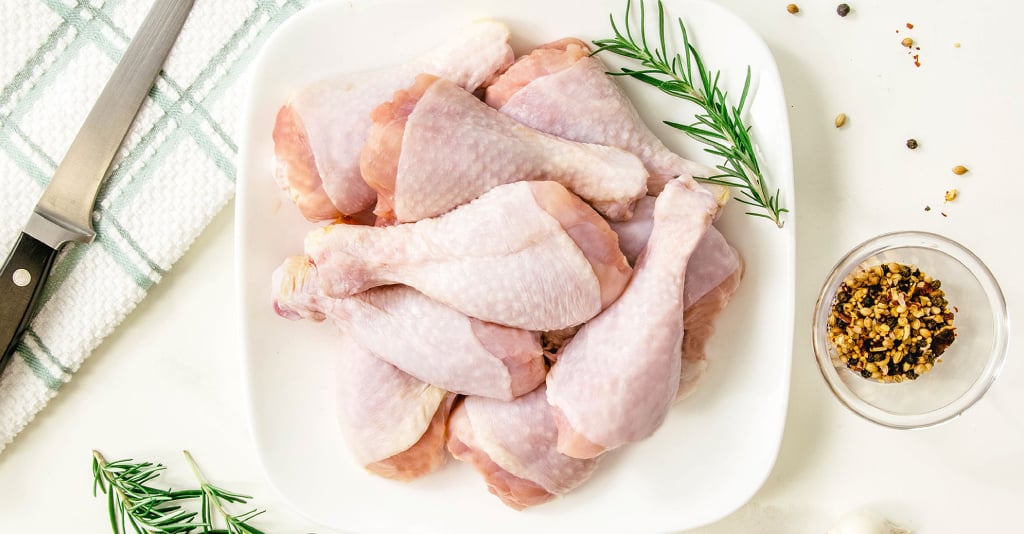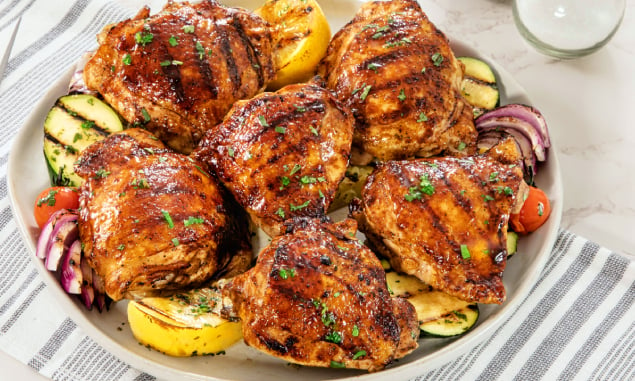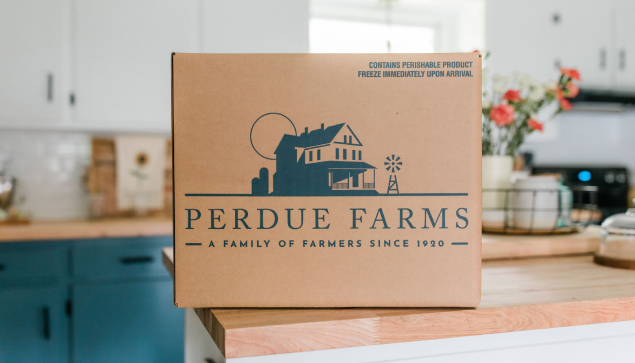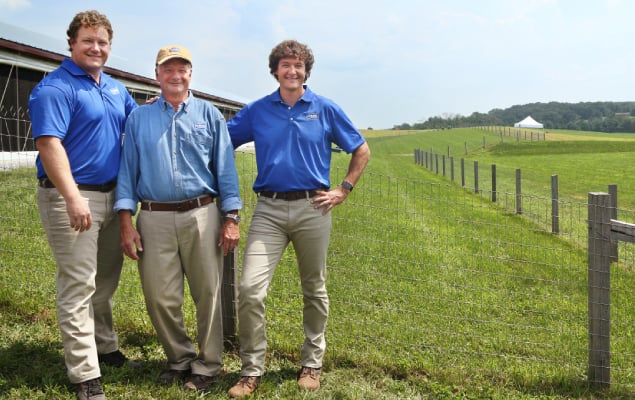
HOW TO THAW FROZEN CHICKEN
We believe that the safest and most effective way to thaw chicken is to place products in the refrigerator.
Defrosting in a steady 34 F environment protects the integrity of meat and keeps muscle fibers intact.
To thaw Perdue Farms chicken products that cannot be cooked from frozen: Remove products from the freezer (keep original packaging on) and place on a sheet tray or other large platter that will capture any liquids that may be released from products as they defrost. Then place tray of product(s) on the bottom shelf of your refrigerator to avoid cross contamination with other items in the refrigerator.
How long does it take chicken to thaw? Here’s a good rule of thumb: A 5- to 6-pound chicken will take approximately 24 hours to defrost, which translates to 4 hours per pound of frozen chicken.
Thawing frozen chicken in water takes less time than refrigerator defrosting, but must be done properly to protect muscle fibers of meat, which retain moisture as the product cooks.
To defrost, place frozen chicken in its original packaging in a container. Place the container in a clean kitchen sink with drain open. Allow 40 to 50 F water to steadily stream over chicken. Drain and refresh water in container every 30 minutes. Allow 30 minutes per 2 pounds of chicken to defrost.
Using a microwave can be the fastest way to thaw chicken. But it may be the riskiest method, as microwaves vary from model to model and defrosting for too long may result in a cooked ― or worse yet, overcooked ― product. Although we don't recommend this method, we offer these tips and suggestions if you are running short on time:
- Microwaving to defrost works for all cuts of chicken, but time may vary based on how many pieces are placed in the microwave. One piece of chicken may thaw fairly quickly; several pieces of chicken may require more time, as electricity is split between pieces.
- To prep chicken for the microwave, remove product from packaging, remove giblet pack from whole bird, if applicable, place product onto a microwave-safe plate and cover with a damp paper towel.
- Microwave power level, presented in percentages, is the amount of time the microwave generator is on during the cooking process. To lessen the risk of cooking product through, set the microwave to 10% cook power when defrosting.
- Don’t set microwave for an extending defrosting time and step away. Work in short time bursts to bring up the temperature of the chicken. Check chicken often for pliability. Turn chicken a time or two to ensure that product is not cooking. Use a digital meat thermometer to check internal temperature of meat, which should be 32 34 F when defrosted; adjust power level to prevent meat from converting too quickly.
- Once product is thawed, season and cook immediately.
We do not recommend this method and here’s why: When frozen chicken is placed on the countertop at room temperature to thaw, the surface of the product defrosts before the inside. By the time the entire product defrosts, the surface area has reached the “danger zone,” between 40 and 140 F, an environment that is ideal for bacteria growth. Air temperature plays a big part too. The warmer your kitchen, the faster the temperature of the product climbs.
According to the USDA, thawed chicken can be stored for 1 to 2 days. Oxygen speeds up the spoiling process, so place defrosted chicken in an air-tight container, a vacuum-sealed container or a vacuum bag.
Defrosted chicken sealed in an air-tight container or bag should be stored in the refrigerator at a consistent temperature of 34 to 40 F.
Your products will arrive at your doorstep fully frozen. Inspect packages for tears or rips, then place immediately in the freezer (or refrigerator, if you plan to defrost and prepare in a day or so).
For questions about ripped or torn packaging or open packages, contact Perdue Farms customer care.
Under the best conditions, products should last up to 365 days in the freezer.
It is possible to safely refreeze chicken if the product has been properly covered with no cross-contamination and stored in the refrigerator at a consistent 34 to 40 F temperature for no more than two days.
Refreezing defrosted chicken does negatively impact the quality. Poultry loses moisture during the defrosting process. If product is refrozen and defrosted again, it will lose more natural moisture and be dry when cooked.
For best results, choose a low and slow cooking method, like braising, stewing, poaching or boiling, as a moist environment will help maintain the product’s natural moisture. If possibly, partially defrost the product so it can hold onto seasoning, and use a digital meat thermometer to keep track of the internal temperature. Make sure the internal temperature of the chicken reaches a minimum of 165 F to reduce risk of foodborne illness.
Points to keep in mind: Boneless chicken breasts will most likely cook faster than bone-in breasts. To fully cook the meat surrounding the bone and the marrow, you run the risk of overcooking the breast meat of a bone-in product. A chicken breast with uniform thickness will cook more evenly than a cut that is thick on one end, with a thinner tail on the other. To check for doneness, insert a digital meat thermometer in the thickest portion of the meat. When cooking a bone-in product, probe the center of the thickest area of meat, as well as right against the bone internally, to ensure the center is at least 165 F and the bone is above 175 F.
Frozen Chicken in the Oven
Create a moist environment by placing chicken in a cooking bag with stock, in a pan with a high lip and a foil cover or a pan with a lid. Place the pan in an oven preheated to 275 to 300 F and cook slowly, being sure to baste the product (if in a pan) throughout the cooking process. Spooning cooking liquid over the top of the exposed meat will ensure a more moist final product. Chicken is done when internal temperature, measured with a digital meat thermometer, reaches 165 F.
Frozen Chicken on the Stove
If product is flat-sided, consider pan searing on both sides, then finishing off in the oven. Searing creates a brown crust and lends flavor to the finished product.
To continue cooking on the stovetop, remove chicken from pan, deglaze the pan with some wine and stock, place chicken back in pan with liquid and pan braise. Braise until internal temperature reaches 165 F with a digital meat thermometer. Braising lends complexity to the pan sauce/braising liquid flavor and boosts the aromatics.
To cook meat for salads, consider poaching, a low and slow method that helps chicken retain moisture, even when chilled after cooking. First, place chicken in a stock pot, add water and heat on stovetop until water temperature reaches 175 to 180 F. Cook until internal temperature of chicken reaches 165 F when measured with a digital meat thermometer.
Precooked and Frozen Chicken Products
Our breaded products are designed to be cooked from frozen. For best results, follow cooking instructions on the package. For the crispiest outcome, consider cooking products in an air fryer or convection oven.
Our pre-cooked or fully cooked grilled chicken breasts and strips should be defrosted before use. Place whole bag or a portion of the product in the refrigerator and thaw overnight or place in a microwave and defrost on the lowest level (see tips above). Once thawed, product can be heated in the microwave, on the grill, in a moist environment, such as an insta-pot or slow cooker, in a saute pan or in the oven. Check that the internal temperature has reached 165 F with a digital meat thermometer before serving.
Our fully cooked chicken wings are designed to be cooked from frozen. If you chose to defrost, cooking time may vary based on method used and preference (moist or extra crispy).
*Disclaimer
These cooking methods have been tested, but cooking conditions may vary. Proper handling, preparation, storage and cooking of food products is recommended, and when possible, it is always recommended that raw poultry be thoroughly thawed in a refrigerator before cooking. Internal temperature of any poultry should always reach 165 F, which should be checked with a food thermometer to ensure food is thoroughly cooked. The recipes and methods described herein are made without representations or warranties of any kind and use of these promotional materials shall be at your own risk.
Chicken Dinner Ideas
Hungry for more? Check out these easy grilled chicken recipes from Perdue Farms' culinary team
Better Chicken for Family Meals
Chicken from Perdue Farms' family of American farmers is raised to a higher standard: no antibiotics, hormones or steroids ever and plenty of access to sunlight and the great outdoors. We believe farming better translates to better-tasting meat. But don't take our word for it! Stock up on premium chicken bundles — we deliver to your doorstep!
Why Choose Perdue Farms
When it comes to the food you feed your family, quality matters. And while there are a lot of options out there, Perdue Farms stands apart. In business for over 100 years, we are a fourth-generation, family owned American food and agriculture business that from the beginning has worked with family farmers.


